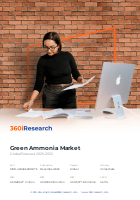
Green Ammonia Market by Production Technology (Electrochemical Nitrogen Reduction, Green Haber-Bosch, Photocatalytic), Power Source (Biomass, Geothermal Energy, Hydropower), Plant Capacity, Storage Type, Application - Global Forecast 2025-2032
SKU
MRR-450A0628D875
Region
Global
Publication Date
December 2025
Delivery
Immediate
2024
USD 283.27 million
2025
USD 392.98 million
2032
USD 5,571.83 million
CAGR
45.11%

Download a Free PDF
Get a sneak peek into the valuable insights and in-depth analysis featured in our comprehensive green ammonia market report. Download now to stay ahead in the industry! Need more tailored information? Ketan is here to help you find exactly what you need.



